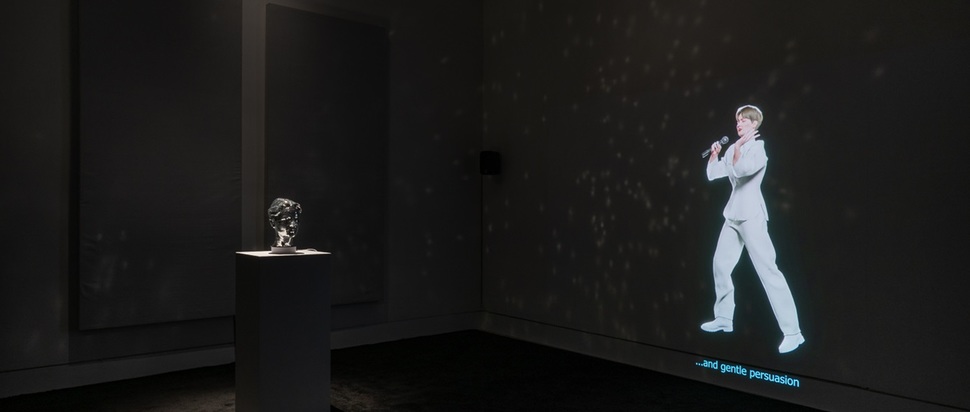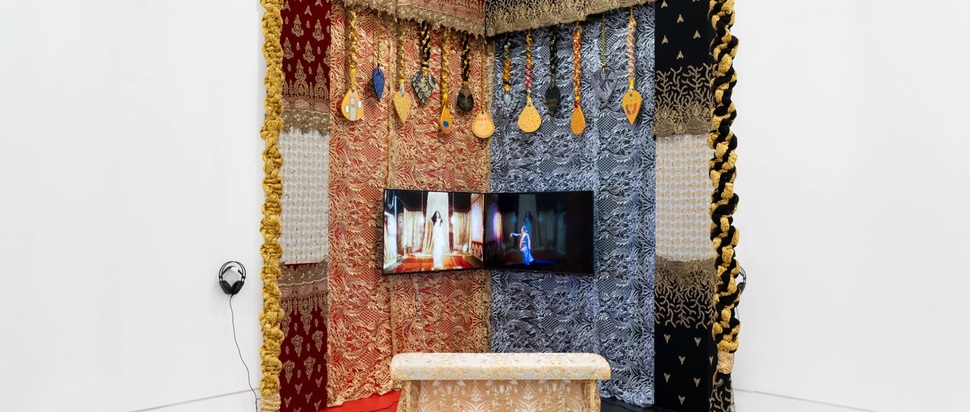Jerwood Survey III @ Collective, Edinburgh
This group exhibition at Collective takes a refreshing anti-institutional stance, with leading artists – not curators – selecting the early-career artists on display
The Jerwood Survey, a biennial touring exhibition, arrives in Scotland for the first time in its third edition, spanning Collective’s three exhibition spaces. Showcasing 10 early career artists, the exhibition fosters an intrinsic dialogue, inviting viewers to not only observe, but activate its emerging themes.
Entering the City Dome, I’m enticed inside by the audio, with Alliyah Enyo’s Aphotic Archaeology. A hypnotic sound piece weaving memory, song, and meditation into a multi-textural 'sonorous myth' that evokes deep-sea whale song. The accompanying installation – incorporating sage, chain, latex, ceramic and metal relics – creates a queer, feminist neo-mythology. Enyo’s work is the show’s anchor – you hear it first, encounter it visually soon after, and its haunting melodies set the tone for what follows. Ciarán Ó Dochartaigh, operating on a similar wavelength, constructs his own archaeological history through a series of sculptures and prints linking surgical bodily modifications with Irish lore and legend. Organic glass and ceramic artefacts complement scientific diagrams of their biological analogies, bridging embodied legacies of trauma, ecological decline, and land rights with the lived experience of chronic illness.
While Ebun Sodipo’s Left Hand of the Sisters collages scanned images of loved ones’ hands into a bronze sculpture, a spectrum of black transness made visible, filling gaps in history and archive, Sam Keelan’s film Tired as the Land observes a scene of gay surrealist domesticity, two figures entwined in bed – one human and the other a human-sized hot water bottle. Keelan’s work unfortunately feels overshadowed. Placed amidst more impactful works, we are not given the legroom to truly observe its durational nuances. Aqsa Arif’s two-channel film Marvi and the Churail, however, establishes a staging, with an extended frame of ornate fabric. Arif explores the multiplicity of womanhood and cultural identity through archetypes of South Asian folklore. Uniting polarities, Arif addresses displacement, migration, and ultimately healing. At moments, Arif’s and Enyo’s audios collide, culminating in a crescendo that underscores a transcendence of individual practice, instead revealing the deep intersections and shared sensibilities amongst the artists.

MV Brown, System of Touch @ Jerwood Survey III. Credit: Rita Silva.
In the Hillside Gallery, we are invited to meditate and reflect upon the exhibition’s nascent themes. Phillipa Brown’s A Summoning (I Would shed my skin for you) collects found materials in an 'intuitive bricolage' of utopian fantasy. Scoring this is Paul Nataraj’s sound installation, centring the sonic materiality of absence. Nine vinyl records in differing states of repetitive nothingness evoke a contemplation on personhood, grief and the ritual of listening.
Che Applewhaite’s untitle 'HANDLE WITH CARE' engages with institutional critique, comprising printed emails, a crystal-clear plinth, a stack of papers and a self-inking stamp. Inviting attendees to collaborate in the work through its gradual removal from the space, Applewhaite’s work encourages active participation, though its success depends on viewers' engagement with the work, which may not always materialise as the artist intended. Kandace Siobhan Walker equally casts an invitation. A double mattress becomes a site for Dreamerism, a rumination on themes of coloniality, dreaming, belonging and spirituality. Invigilators observed how the space has naturally transformed into a site where visitors linger, reflecting Walker’s exploration of collective contemplation.
Finally, behind a sheer black curtain in The Library, MV Brown’s System of Chance provides an opportunity to frolic, as an AI avatar of Brown leads us in a karaoke performance. Though playful in form, Brown addresses identity in an increasingly digitised world, interacting with cyber-feminist and transhumanist theory.
At its core, Jerwood Survey III rejects institutional modes of exhibition-making, with each participating artist nominated by another rather than selected by directors. This non-institutionality pervades the third edition, emphasising participation and the fluid interplay of sound, installation, film, and sculpture. Collective’s non-white cube space allows a cohesivity between the artists – a dialogue that didn’t exist in its earlier iterations. The show feels refreshingly stimulating, contrasted with Scotland’s current exhibition landscape, often dominated by retrospectives. Jerwood Survey III reaffirms the importance of artist-led approaches in shaping contemporary discourse and expanding the possibilities of exhibition-making.
Jerwood Survey III, Collective, Edinburgh, until 4 May, free
